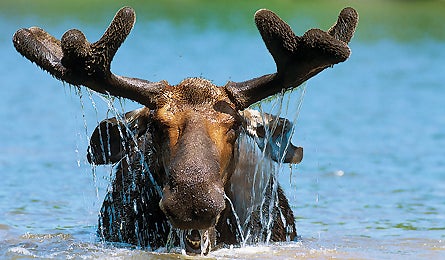Wildlife: Where to See Moose

'Moose can swim for miles. (Michael H. Francis)'
Range
Throughout Canada, Alaska, New England, the northern Great Lakes region, and the northern Rockies
Where
>> Open spaces like rivers and ponds When not at a watering hole, moose tend to disappear into thick forests.
>> Roadside ditches during spring thaw That’s where the first green shoots appear, says Dan Legere, a Master Maine Guide. The vegetation—salted with road residue—attracts hordes of moose. Once the forest greens up, moose disperse to browse.
>> Lowland marshes Moose inhabit the bogs and low country between mountains. “You’re more likely to see them near the trailheads than the summits,” Legere says.
When
>> Fly season In Maine and many parts of Canada, the best viewing season is when black flies are the worst—generally from Mother’s Day to Father’s Day. That’s when moose head for water to escape the bugs. You also have good odds in July and August, when moose munch water lilies and water grasses (the sodium in water plants contributes to antler development). In autumn, when those plants die off, moose gravitate to clearcut areas to chomp meadow plants.
>> Dawn and dusk Moose are nocturnal.
How
>> Key into the moose’s routine. “Just like people go to the same restaurant every morning for coffee, moose start the day at the same bog,” Legere explains. If you notice moose tracks near a watering hole in the afternoon, come back at dawn—there’s a good chance you will see the bog’s regular customer.
>> Approach a moose head-on to avoid spooking it. “Moose pick up on lateral movement immediately,” Legere says. “But if you travel straight toward it, you lessen the appearance of motion, and just get larger in its field of view.” In the wild, moose have a comfort zone of about 50 yards; closer than that, and they may charge or flee, so keep a safe distance.
>> Learn the mating call. During the rut (mid-September to mid-October), otherwise-solitary moose congregate to breed. Cows make a grunting sound to indicate they’re receptive to a bull, and hunters sometimes imitate that grunt to attract males. “I’ve had as many as five moose come running from five different directions to one call,” Legere says. Learn to imitate the sound (watch Calling Trophy Moose with Wayne Carlton; $14, gamecalls.net), or buy a moose horn or digital moose call ($30, phantomcalls.com). “There’s no real danger,” says Legere, “because he comes with love in his heart.”
>> Approach bogs and ponds from downwind, even if you don’t see the moose yet. Though this tip holds true for most any animal you want to spot, moose have a very sensitive sense of smell, and they will flee before you even see them.
Top spots
Central and northern Maine lay claim to the densest moose populations. Hit any trailhead near the Rangeley and the Moosehead Lake regions, or head to Greenville, where moose are said to outnumber people three to one. In Minnesota, hike the moose-mobbed Superior Hiking Trail, CR6 to Silver Bay (18.6 miles round-trip), with spectacular, airy views overlooking Lake Superior. The greater Yellowstone area and Colorado also have Bullwinkles: Explore Wyoming’s Gros Ventre River, or Colorado’s State Forest State Park, west of Fort Collins.